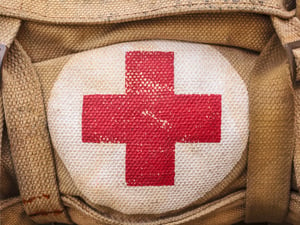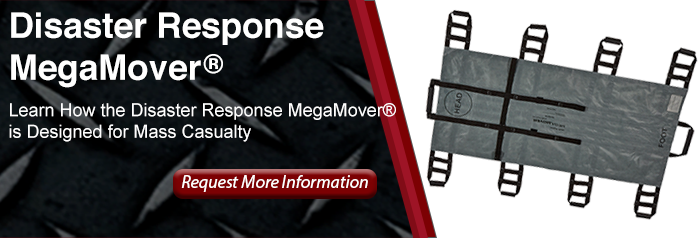 EMS first responders are having to add another skill set to their emergency training — combat medicine. This specialized branch of trauma care, also known as field surgery is administered by military medics to treat the wounded in and around areas of combat. Today, rising violence in urban environments sees EMS first responders dealing with trauma cases similar to their military counterparts.
EMS first responders are having to add another skill set to their emergency training — combat medicine. This specialized branch of trauma care, also known as field surgery is administered by military medics to treat the wounded in and around areas of combat. Today, rising violence in urban environments sees EMS first responders dealing with trauma cases similar to their military counterparts.
To better prepare EMS first responders for these volatile situations, military and EMS training partnerships are being set up throughout the US. These efforts are introducing military medical care to the frontlines of city trauma.
Building on the past
Modern EMS tools and treatment protocols owe much to military medics and the pioneering treatments they’ve deployed in times of conflict. According to the Journal of Emergency Medical Services, we can draw a direct line from today’s EMS to the battle casualty transportation system that was used during Napoleon’s European campaigns.
The mid-1950s through to the 1970s saw military veterans training emergency personnel like firemen, police and EMS. This partnership between medicine, public safety and emergency services leadership resulted in an advanced prehospital care movement that spread across the country. Ambulances became specialized patient carriers, and other emergency workers such as firefighters and police officers started enrolling in first-aid programs to further their medical training.
For nearly twenty years the War on Terror has facilitated the development of emergency equipment and processes whose efficacy greatly exceeds the treatment methods used in the past. This has enriched the modern EMS first responder with proven life-saving techniques for urban trauma care. According to an article by EMS1.com, programs to help former military medics transition from service to civilian EMS and paramedic careers — such as the Lansing Community College curriculum — are being introduced more frequently to channel this much-needed transfer of skills.
Tactical EMS adoption
Increasing mass casualty events and “active shooter” incidents are directly responsible for the growth of Tactical EMS, a once-niche subspecialty of emergency response. The Tactical Medic is an intermediary between emergency personnel who arrive first on-scene and law enforcement teams that secure the trauma scene. Their task is to brief EMS supporting units and safeguard them in and out of the ‘warm zone’ once the threats have been eliminated. According to this tactical EMS article in EMS1.com, three Tactical EMS models have emerged:
- Agency Contract: Refers to the medical care memorandum of understanding (MOU) between law enforcement agencies and their local EMS provider.
- Individual Contract: Individuals who have set out a contract between themselves and the law enforcement agency responsible for SWAT missions and training coverage.
- ALS Standby: While not Tactical Medics per se, this refers to the Advanced Life Support units that respond once law enforcement has secured a scene.
Combat medicine training programs throughout the US
As interest in the specialty grows, programs like the NAEMT Tactical Combat Casualty Care (TCCC) have been established to arm trainees with the necessary skills and knowledge for better treatment of trauma patients.
The International School of Tactical Medicine (ISTM) administers the “best medicine in the worst place” through a cooperative effort between the California Commission on Peace Officer Standards and Training (POST) and the California Emergency Medical Services Authority. This is the first federally approved tactical medicine training program in the United States and takes place over 2 intensive weeks.
The United States Special Operations Command (USSOCOM or SOCOM) also offers combat medicine-specific certifications such as the Advanced Tactical Paramedic Program. Once students have received this certificate, they can go on to make use of existing partnerships — like the one between Cooper EMS and SOCM students — to help them better prepare for the National Registry test.
The answer to rising urban violence lies in shared knowledge
As Blake Stilwell from We Are The Mighty notes, so closely do city conflicts mirror overseas warzones that U.S. military medics have been honing their treatment skills in the most violent urban epicenters of America. When interviewed by the LA Times, Navy Cmdr. Peter Rhee, Director of the Trauma Training Center at the Los Angeles County-USC Medical Center said: "The first night I took calls here, it was unbelievable. We ended up opening five chests; we had 10 people shot in the chest. We were operating all night long. It was truly as bad as any kind of wartime experience you could have."
With the military using America’s cities as training grounds for real-life battle scenarios, EMS first responders and their civilian trauma patients would clearly benefit greatly from combat medicine training. As new programs are implemented nationwide and interest in the field grows, we’re witnessing the emergence of a new, exciting area of emergency treatment.
To enhance civilian EMS combat medicine training, new tactics and tools are being developed to ensure the safety of first responders and their patients. The MegaMover® Portable Transport Unit by Graham Medical is one such tool. Constructed to meet the unique needs of patient transport and casualty evacuation in urban areas, it’s tailor-made for volatile environments that require first responders to take quick, decisive action in service of their patients.
Contact us to request a sample of the MegaMover® Portable Transport Unit.

